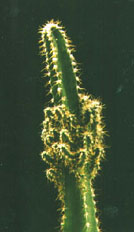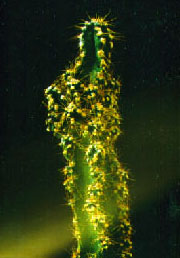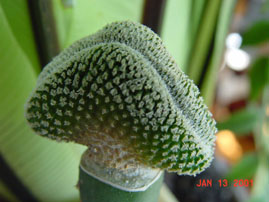Monstrous Cereus
By Walery Kalishev
 |
| Photo 1. |
The article "Your Opinion" (№ ?) referred to the usage of a preparation "Gibbersib" and fertilizers. I was surprised not only by mass blooming of Gymnocalcium but also by appearance of monstrousness of one of the Cereus.
First it was a normal Hylocereus or as we call them "trihedron" which served as a stock for the lost Dutch Gymnocalcium. I left it for cuttings. In 3 or 4 months I got first cuttings, not with 3 but with 4 ribs like of Cereus. Later it turned out that this Cereus can not make a good stock as it is very weak and the plants grafted on it die. I can't say now what saved Cereus from being thrown out but several of them remained and grew among other cacti destined for cuttings. They reminded of themselves in a rather weird way. One day I was amazed at seeing among "trihedrons" a cactus with lots of lateral shoots which looked like a monstrous Cereus (photo 1 - 2). After examining it I realized that it was one of those Cereus that survived. The rest of Cereus turned to be monstrous too.
What was the reason of turning them into monstrous form?
Here is Igor M. Skoulkin's answer.
 |
| Photo 2. |
He does not believe that any cactophiles or botanists will answer this question. We do not know what exactly leads to sharp changes in the appearance of a particular plant, what genes switch on and off and may be new somatic mutations take place in a particular areola.
We can conjecture for a long time. But we should pay attention at several facts.
1. Several years ago Igor Skoulkin wrote in "Cacti and not only" about a case caused by abnormal conditions of keeping Epiphyllum (dryness, darkness and so on) which developed 4- and 5-ribbed shoots. Though you should remember that Epiphyllum is a bigener of 4 different genera of cacti including Hylocereus, Aporocactus and others. All of his predecessors are 4-ribbed. The author explained the fact by a sudden "switching" of genetic programs, more precisely by "switching off" one of the genes (of one parent) and "switching on" others (of another multi-ribbed parent).
2. There is a phenomenon known in plant selection since I.V.Michurin. It is control over dominance of genes of young hybrid plants got as a result of a distant hybridization of different genera and species. Michurin placed such hybrids into conditions that favored the appearance of the genes of a particular parent. In fact the controlled dominance of genes and made one parent's genes dominate over others.
3. Michurin also noticed that the heredity of hybrid plants is impaired. When the proportion of genes in genotype of a species settled during millions of years meets the genes of a different species it does not know how to behave. They can not decide which of them, when and in what conditions will dominate.
Crested Pelecyphora
By Yuriy Zhourov, Vladivostok
 |
| Photo 3. |
In summer 1994 I spent my vacations in St.Petersburg and dropped to Pavel P. Melnikov. I was given as a gift a number of plants. Among them there was a graft - Pelecyphora pseudopectinata f. cristata looking like a 4-cm horseshoe grafted onto a small Hylocereus. As I remember, in those times Pavel P. Melnikov was keen on mass sowing. He grew more than 100 seedlings and got 4 or 5 crested forms. All the crests were shaped differently. I just received one of those seedlings. I planted the cactus and watched the crest developing for several months. The graft remained in the same condition for about 2 years. The lower parts of the crest set against the upper part of the stock and could overgrow it with time. To my pleasure the next spring new crest started growing on the exterior part of the crest. As though the grafter felt that there is no space to grow to the sides, only to form "the second floor". The photo shows the graft that I brought in 1994, it was made in January 2001 (Photo 3). Now the plant looks different but it still develops new young crests.
 |
| Photo 4. |
After "the second floor" appeared on the crest of the grafter it was not difficult to make new grafts. When I removed a part of the exterior crest it almost did not spoil the general view of the plant.
Below you can see the photo of a new graft made in December 2000. The stock is Selenicereus (Photo 4).
The grafter turned to be rather stable. I made lots of grafts on different types of stocks. I had practically no problems.
The only drawback is predisposition to red spider's (brevipalpus odovatus) attacks. But it also refers to normal plants. It leaves ugly red spots that spoil the plant almost forever.
Blooming of Crests
Igor Skoulkin
Crests bloom rarely. The first report about the blooming of crest (Chamaecereus silvestrii) was published in 1966. Later similar reports were published quite often. The authors said that crests could have both normal and fasciated flowers. One of the versions why crests bloom rarely is as follows. The physiological age of the crest may not depend on its actual age and be determined by the stage when it appeared. It's quite possible that the crest that appeared on a juvenile plant will never be able to bloom. Most of crests in collections appear on seedlings or young plants.
There are different opinions of their rare blooming. I think that to purely biological reasons we should add the factor of vegetative propagation. It is commonly known that a cactus propagated by cuttings is reluctant to bloom. But this is the way crests are propagated! There is an indirect proof of it. My native Mammillaria carmenae f. cristata never bloomed, but foreign Parodia, Turbinicarpus and Pelecyphora bloom without any problem.
Here is Walery Serovayskiy's opinion: If the crest appears on a seedling that has already bloomed it will bloom (it is already grownup). If the seedling is crested since its "childhood" the crest will not bloom. If the crest gave a type head it will bloom.
Translation Irina Koudina (Okounkova , Mosсow, Russia, e-mail: irinkos2@yandex.ru





